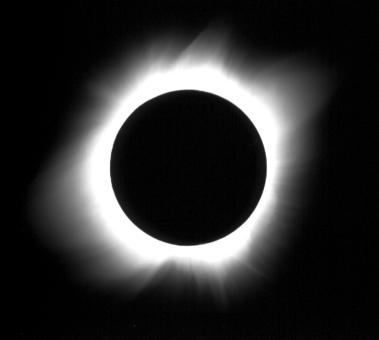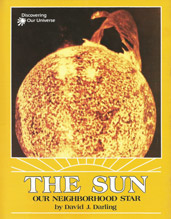THE SUN: Our Neighborhood Star - 3. Sun-watching

Figure 1. A group of sunspots. Each spot is darker in the middle than at the edge.

Figure 2. A total solar eclipse with the corona in view.
Of course, we can't actually see inside the Sun. No real spacecraft has ever gone there, for it would be melted on approach by the tremendous heat. How, then, are we able to learn so much about our neighborhood star?
One way is by breaking the "secret code" contained in sunlight. Amazingly enough, even the tiniest sunbeam carries with it a great deal of information about the place in the Sun where it came from.
Secrets of the Spectrum
If we pass sunlight through a glass triangle – a prism – we find that the light is made, not just of one color, but of many. What looks like white sunlight is really a mixture of all the colors of the rainbow. The split-up sunlight forms a spectrum of colors stretching from red through orange, yellow, green, blue, indigo, to violet.
Using a special instrument, called a spectroscope, scientists can get a much clearer look at the spectrum of sunlight. In this way they can uncover something even more surprising about it. Not only is the Sun's spectrum made of many colors, but it is also crossed by hundreds and hundreds of dark, narrow lines. These are called Fraunhofer lines in honor of one of the first scientists who noticed them.
The Fraunhofer lines carry the secret code in sunlight. They are made by substances high up in the Sun that absorb light coming from deeper down. By studying these lines, scientists have learned what the outside of the Sun is made of and how hot and dense it is.
The Sun Seen from Earth
Another way we can learn about the Sun is simply by looking at it. The problem is how to do this safely. If we gazed straight at the Sun or tried to view it through an ordinary telescope, it would be so bright that it would blind us.
To view the Sun safely, scientists use special solar telescopes These have mirrors that track the Sun across the sky, collect its light, and form an image, or picture, of its brilliant disk on a large, flat viewing table.
The bright surface of the Sun is known as the photosphere. It is a bubbling, boiling, bursting brew of hot gas. Seen through a solar telescope, the Sun's surface is always shifting, always alive with movement.
There are, for instance, tiny freckles that cover the entire surface of the Sun. Scientists call these granules and believe they are caused by hot gases that well up from deeper in the Sun, cool, and then fall back down again. The pattern of granules presents a dotlike, ever-changing picture (see Figure 1).
Sunspots are much larger and darker spots on the face of the Sun. They may last a week or more and may be big enough to swallow several Earths. A sunspot is an area of the Sun's surface that has been made a little cooler than its surroundings. Because the center of the sunspot is cooler than the rest of the Sun's surface, it looks dark. But a sunspot is still quite hot – around 7,000°F (4,000°C) – and, by itself, a large one would look as bright as the full Moon!
Sunspots are formed when the Sun's magnetic field bursts up through the photosphere. Since the magnetic field then usually loops back around into the surface, a second sunspot may be formed. These loops are the reason sunspots often occur in pairs.
Sometimes there may be no sunspots for several weeks. At other times the Sun's face seems peppered with them. Their position changes daily as the Sun slowly turns on its axis. Over a period of years, the average number of sunspots gradually goes up, hits a peak, and then gradually falls off again. The sunspot peaks happen about every eleven years, and the whole pattern of their change is known as the sunspot cycle.
The Sun eclipsed
The bright surface of the Sun that we see isn't where the Sun ends and outer space begins. The Sun also has a huge atmosphere – a layer of gases outside the photosphere – that we can't usually see.
Only at a very special time can we get a good view of the Sun's much dimmer atmosphere. It is during a total eclipse of the Sun.
You may have noticed that the Moon and the Sun seem to be about the size in the sky. (In fact, the Moon is really much smaller and closer to us.) Once in a while, the Moon passes exactly between the Sun and the Earth. Then, from some parts of the Earth, the Sun's bright disk is completely blotted out by the Moon (see Figure 2).
During a few minutes of total eclipse, we get a thrilling glimpse of what is going on above the surface of the Sun. For a short time, just at the start and at the end of the total eclipse, we see a thin, pinkish, curved ring around the edge of the Sun. This is the chromosphere - the bottom part of the Sun's atmosphere. The chromosphere is like a bubbling foam of gases, a few thousand miles deep, thrown up by the "sea" of the photosphere.
During the middle of the eclipse, we see the beautiful, glowing corona – the top part of the Sun's atmosphere. Although the corona is made of only very thin, very hot gases, it is huge. It stretches more than a million miles out from the Sun in every direction!
Total eclipses also provide us with marvelous views of prominences. These are great clouds of slightly thicker gas that form in the corona and then rain down onto the Sun's surface. They look like giant flaming tongues.
Another, rarer type of prominence – the eruptive prominence – is caused by gas bursting out of the Sun's surface. In fact, it is just one of the ways in which the Sun can shoot matter into space.
From Sun to Earth
A strange kind of wind – the solar wind – carries about one million tons of the Sun into space every second! Some of the tiny, fast-moving particles in the solar wind reach Earth and get trapped in the magnetic field that stretches all the way around our planet. A small portion of the solar wind particles manage to leak out at the poles. They rise into the air and cause a wonderful shimmering glow in the sky. This is how aurorae are made.
The solar wind blows especially hard following a solar flare – an explosion of the Sun's surface that sends a sudden burst of particles into space. Solar flares cause magnetic storms around the Earth. For a while, the aurorae become brighter, and radios and compasses behave in an odd way.
Scientists know of other things, too, that the Sun gives off. Radio waves and X-rays reach the Earth from the Sun's surface. And huge armies of strange, ghostly particles, called neutrinos, march out to meet us from the Sun's core.
By building special instruments on Earth, and by launching others on satellites, we can study what the "radio Sun," the "X-ray Sun," and even the "neutrino Sun" look like. In this way, we can gain a better understanding of how our neighborhood star works.

